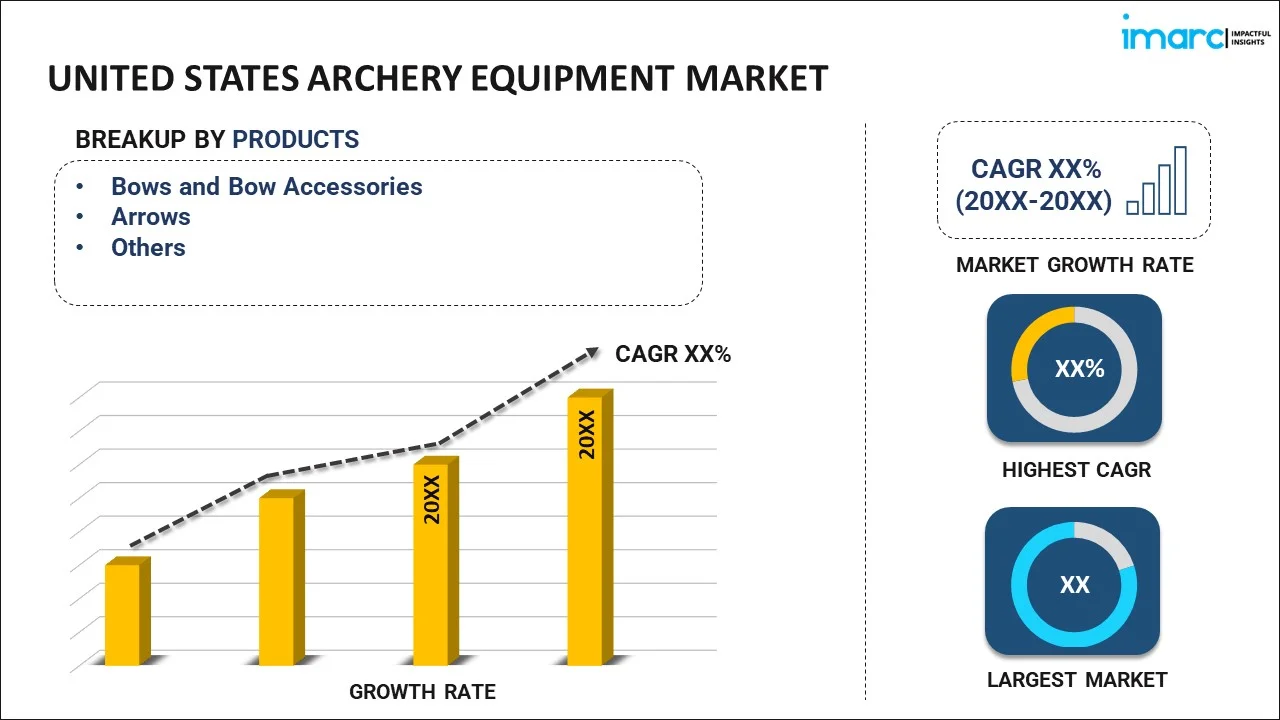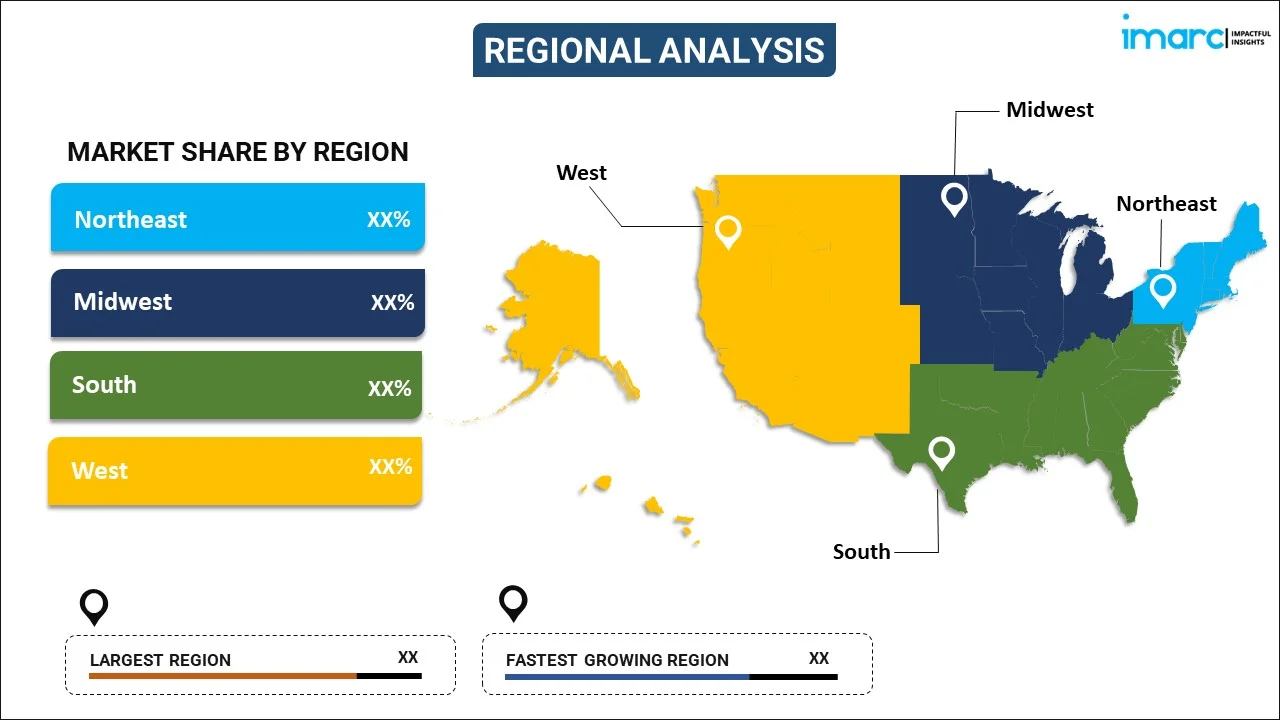
United States Archery Equipment Market Report by Product (Bows and Bow Accessories, Arrows, and Others), End User (Individual Consumer, Clubs and Gaming Zones, Sports Organizers), Distribution Channel (Speciality and Sports Shops, Departmental and Discount Stores, Online Stores, and Others), and Region 2025-2033
Market Overview:
The United States archery equipment market size reached USD 1.2 Billion in 2024. Looking forward, IMARC Group expects the market to reach USD 1.9 Billion by 2033, exhibiting a growth rate (CAGR) of 4.47% during 2025-2033.
|
Report Attribute
|
Key Statistics
|
|---|---|
|
Base Year
|
2024
|
|
Forecast Years
|
2025-2033
|
|
Historical Years
|
2019-2024
|
|
Market Size in 2024
|
USD 1.2 Billion |
|
Market Forecast in 2033
|
USD 1.9 Billion |
| Market Growth Rate 2025-2033 | 4.47% |
Archery equipment refers to a set of tools and gears utilized while doing archery. It comprises arrows, bows, finger tabs, bracers, stingers, targets and bow stands. Amongst these, the bow is a flexible staff attached to a string at both ends, which is utilized for pulling the arrow. An arrow is a long stick with a pointed tip and stabilizer fins mounted against the bowstring.
The US Government is undertaking numerous initiatives to conduct archery programs for children in schools. It is organizing competitions that promote archery as a professional sport and encourage public participation. This represents one of the key factors creating a positive impact on the archery equipment market. Apart from this, the burgeoning e-commerce sector, in confluence with aggressive promotional campaigns initiated by leading players, is strengthening the market growth. However, the coronavirus disease (COVID-19) outbreak, imposition of lockdowns in the country and temporary halt in the operations of several manufacturing units have negatively influenced the market. It will subsequently witness growth once lockdown restrictions are uplifted.
Key Market Segmentation:
IMARC Group provides an analysis of the key trends in each sub-segment of the United States archery equipment market report, along with forecasts at the country and regional level from 2025-2033. Our report has categorized the market based on product, end user and distribution channel.
Breakup by Product:

- Bows and Bow Accessories
- Arrows
- Others
Breakup by End User:
- Individual Consumer
- Clubs and Gaming Zones
- Sports Organizers
Breakup by Distribution Channel:
- Speciality and Sports Shops
- Departmental and Discount Stores
- Online Stores
- Others
Breakup by Region:

- Northeast
- Midwest
- South
- West
Competitive Landscape:
The competitive landscape of the industry has also been examined along with the profiles of the key players.
Report Coverage:
| Report Features | Details |
|---|---|
| Base Year of the Analysis | 2024 |
| Historical Period | 2019-2024 |
| Forecast Period | 2025-2033 |
| Units | Billion USD |
| Segment Coverage | Product, End User, Distribution Channel, Region |
| Region Covered | Northeast, Midwest, South, West |
| Customization Scope | 10% Free Customization |
| Post-Sale Analyst Support | 10-12 Weeks |
| Delivery Format | PDF and Excel through Email (We can also provide the editable version of the report in PPT/Word format on special request) |
Key Questions Answered in This Report
The United States archery equipment market was valued at USD 1.2 Billion in 2024.
We expect the United States archery equipment market to exhibit a CAGR of 4.47% during 2025-2033.
The rising popularity of archery as a recreational sport, particularly among the millennial population, is primarily driving the United States archery equipment market.
The sudden outbreak of the COVID-19 pandemic has led to the changing consumer inclination from conventional brick-and-mortar distribution channels towards online retail platforms for the purchase of archery equipment across the nation.
Based on the product, the United States archery equipment market can be divided into bows and bow accessories, arrows, and others. Currently, bows and bow accessories account for the majority of the total market share.
Based on the end user, the United States archery equipment market has been segregated into individual consumer, clubs and gaming zones, and sports organizers. Among these, individual consumer currently exhibits clear dominance in the market.
Based on the distribution channel, the United States archery equipment market can be bifurcated into speciality and sports shops, departmental and discount stores, online stores, and others. Currently, speciality and sports shops hold the largest market share.
On a regional level, the market has been classified into Northeast, Midwest, South, and West, where West currently dominates the United States archery equipment market.
Need more help?
- Speak to our experienced analysts for insights on the current market scenarios.
- Include additional segments and countries to customize the report as per your requirement.
- Gain an unparalleled competitive advantage in your domain by understanding how to utilize the report and positively impacting your operations and revenue.
- For further assistance, please connect with our analysts.
 Inquire Before Buying
Inquire Before Buying
 Speak to an Analyst
Speak to an Analyst
 Request Brochure
Request Brochure
 Request Customization
Request Customization




.webp)




.webp)












